Mark Sisson's Blog, page 288
September 4, 2014
Why We Eat: Other People
 For those of you who did a double-take, how could I resist? It’s not only an example of why punctuation matters but another major reason why we hominids chow down (in addition to the hunger and cravings we discussed the last couple of weeks). Ah, the power of social suggestion… Think for a moment about your experience, and compare eating alone to eating with others. Maybe it’s helpful to break it down further. What is it like to eat with your partner? Your kids? (Yup, that one definitely belongs in a category all its own.) Your extended family? Your friends and neighbors? Strangers? Obviously the particular function and arrangement of the gathering matters (e.g. a raucous Super Bowl party versus an intimate lunch with friends versus a formal cocktail hour). All these factors likely influence our choices and even the mindfulness behind our choices. With our own stories in mind, how do they line up with the research on social eating? What’s really behind the influence of others’ presence anyway? Finally, what’s a good Primal take on the pressures and benefits of social eating?
For those of you who did a double-take, how could I resist? It’s not only an example of why punctuation matters but another major reason why we hominids chow down (in addition to the hunger and cravings we discussed the last couple of weeks). Ah, the power of social suggestion… Think for a moment about your experience, and compare eating alone to eating with others. Maybe it’s helpful to break it down further. What is it like to eat with your partner? Your kids? (Yup, that one definitely belongs in a category all its own.) Your extended family? Your friends and neighbors? Strangers? Obviously the particular function and arrangement of the gathering matters (e.g. a raucous Super Bowl party versus an intimate lunch with friends versus a formal cocktail hour). All these factors likely influence our choices and even the mindfulness behind our choices. With our own stories in mind, how do they line up with the research on social eating? What’s really behind the influence of others’ presence anyway? Finally, what’s a good Primal take on the pressures and benefits of social eating?
Researchers have delved into questions of both what we’ll eat and how much we’ll put away when we’re with a group as opposed to on our own. Little surprise that studies show we tend to align our choices with those around us, particularly those right in front of us. While many experts have long noted that we eat more in a social setting than by ourselves, we also apparently eat more in larger groups than smaller groups.
The social shift and attunement only gets more striking with further examination. Researchers have even videotaped and counted thousands of individual bites to demonstrate how subjects (women who hadn’t met before but were paired for the purpose of the study) “synchronized” their eating with that of their companions. Add to this tendency toward behavioral mimicry the penchant of some for people pleasing and you’ve got a consistent recipe for overeating, according to one Case Western Reserve University study.
However, the “socially transmittable” effect can go both ways. In a review of 15 food intake studies, researchers found that what participants viewed as “norms” significantly influenced their eating decisions. When subjects thought others were choosing high calorie foods or large amounts of food, they chose high calorie foods for themselves, but the opposite held as well. Those who believed others in the group were eating low calorie choices or smaller portions selected the same for themselves. According to the authors, “It appears that in some contexts, conforming to informational eating norms may be a way of reinforcing identity to a social group.” In other words, we make our eating choices in part based on the “need to solidify our place in our social group.” (I can imagine Grok for his part nodding at this insight.)
While we can talk about the power of public service messages in keeping with our sense of “norms,” we’re also mentally contending with the influence of food marketing. In the face of contradiction (and maybe even not), we’re likely looking to those people around us. Conceptualizing a survey of 28,000 randomly selected households probably doesn’t appeal as naturally to the hominid brain as the visual of what their neighbors are eating. To support this idea comes an Australian study that suggests the diet and exercise habits of our personal contacts influences our own.
What should we take from all this? Obviously, no one is suggesting shutting ourselves in like hermits or hiding in seclusion every time we take in a scrap of food. (Although creating a circle of like-minded Primal friends can certainly help.) That said, the presentations (at least the popular media versions) of this research are often tinged with an odd mix of finger-waving “shame on you” and rib jabbing “yeah, don’t we all?”. I find this contrary messaging typical and annoying.
First off, how about putting away the self-judgment? (Seriously, has this ever helped anyone?) Shaming/self-shaming has nothing in common with the cognitive recognition that a particular choice isn’t going to do you any favors in the long run. That plate of nachos everyone is digging into at the Friday happy hour? It won’t seem like such a good deal at 10:00 tonight. The birthday cake at Aunt Helen’s fete looks lovely but probably would be better preserved as sentimental decor rather than eaten. Nonetheless, the choice isn’t a character issue. It’s a cognitive decision.
With that said, how about trading the sophomoric bonding over transgression for a light-hearted recognition of our literal “monkey see, monkey do” selves? I think the meta-analysis gets at this approach the best. We’re motivated by the prospect of group acceptance. Note: recognition doesn’t mean license. If we accept that we’re wired to be tempted toward these patterns, it’s not a green light to act on the inclination. What’s understandable isn’t necessarily productive. We’re talking about clarity, not carte blanche.
When we’re clear about being wired to mirror the actions of those around us in an often unconscious attempt to gain acceptance, we can choose to be more aware and act differently. What made sense in evolution (and even today in other contexts) doesn’t do as much good over a bag of Doritos and a case of Miller. Maybe it’s a case of studying our own behavior, noticing our own primeval patterns and asking what would YOU tell Grok to do in this scenario if it were him sitting in a restaurant with several appetizers between him and his modern companions? Can we imagine a little humorous but protective compassion to share with our good Primal fellow – and, likewise, ourselves?
Thanks for reading, everyone. What’s your experience (past or present) with social eating? Offer up your feedback and stories, and enjoy the end of your week.
Further Your Knowledge. Deepen Your Impact. Become an Expert! Learn More About the Primal Blueprint Expert Certification




September 3, 2014
11 Signs You’re Not As Healthy As You Think You Are
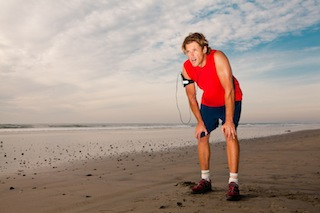 You could be the picture of health to everyone who beholds you, feel generally “okay” on a daily basis without any real complaints, and never really feel compelled to visit the doctor for any specific issue. Plus, you’re Primal, so what could possibly go wrong? Except that many of us, if we stop to think about it, have little niggling symptoms that annoy us. And some of them could portend more serious conditions. I don’t want to worry anyone or freak you guys out. I just want you to be aware of seemingly inconsequential symptoms before they become more serious.
You could be the picture of health to everyone who beholds you, feel generally “okay” on a daily basis without any real complaints, and never really feel compelled to visit the doctor for any specific issue. Plus, you’re Primal, so what could possibly go wrong? Except that many of us, if we stop to think about it, have little niggling symptoms that annoy us. And some of them could portend more serious conditions. I don’t want to worry anyone or freak you guys out. I just want you to be aware of seemingly inconsequential symptoms before they become more serious.
I’ve omitted the obvious signs that people don’t ignore, like blood in the toilet or the sudden inability to bear weight on one leg, to focus on the subtler symptoms that many of us take for granted.
You drag through every day.
Maybe it’s your job boring you to tears. Maybe it’s the long commute robbing you of valuable sleep. Maybe man wasn’t meant to sit in a cubicle during the best hours of the day. Maybe you’ve just had a bad week. Maybe you’re still on a high-carb diet, or you’re transitioning to a low-carb one. Those are all reasonable reasons to be tired throughout the day, but it could be something else. If you find yourself nodding off on a consistent basis all day, every day, and the aforementioned causes don’t apply, consider conditions like hypothyroidism, diabetes, hypothalamic pituitary axis (HPA) insufficiency, or chronic fatigue syndrome (CFS).
See a doc or health professional experienced with CFS or HPA insufficiency. Get thyroid and blood sugar tests.
You sleep poorly.
Good sleep is a pillar of good health. It’s really, really hard – bordering on impossible – to be healthy, lean, and fit without a solid 7-8 hours of sleep a night. Many people think they’re getting away with it, tossing around pithy quotes like “sleep is for the dead,” but they’re really just getting by. And not for long. Eventually, it catches up. Inadequate sleep is linked to early mortality from all causes, while partial sleep deprivation directly leads to insulin resistance, overeating, and body fat gain.
Manufacture a great night’s sleep.
You snore consistently.
One health risk associated with consistent snoring is being smothered in your sleep by whoever has to listen to it. Another is sleep apnea. Regular snorers may have obstructive sleep apnea (OSA), a disease that involves obstruction of the upper airway, frequent (but unbeknownst to the sleeper) awakenings, and 20-40 second long pauses of breathing during sleep. Yes, if you snore all the time, you might be holding your breath while you sleep. People with OSA are often inexplicably tired during the day (because of the awakenings and poor sleep). OSA is also linked to metabolic syndrome, cardiovascular disease, hypertension, cancer, and diabetes.
Get checked out by your doctor. A sleep study may be in order.
You can’t drag yourself out of bed in the mornings.
Beds are hard to leave. I get that. They’re soft, warm, inviting. But you should be able to get out of bed if you really need to get on with your day. You shouldn’t languish daily against your better judgment. If you are, something’s wrong and needs fixing. Remember, that same study showing a link between low sleep duration and early mortality also found a link with long sleep duration (although a later study found that sleeping for a long time only increased mortality in sedentary people). A common culprit (assuming you’re not getting to bed too late or sleeping poorly in general, which I’ve already covered) is low morning cortisol, which has been shown to be an accurate predictor of hypothalamic pituitary axis insufficiency.
Test your diurnal cortisol rhythm. Get plenty of bright, natural light in the morning and during the day, but not at night.
You injure yourself frequently.
Frequent injuries can mean several things: you’re training too much or too hard, you’re not giving yourself enough time or food to recover from your workouts, you’re using poor form, you’re wearing the wrong shoes, you’re moving the wrong way, you’re deficient in key micronutrients. Whatever the cause or causes, someone who’s always injured, or always getting injured, is not a healthy person. You should be able to to move relatively pain-free.
Watch out for overtraining, shore up your micronutrient intake, sleep adequately, and eat an anti-inflammatory, anti-arthritis diet.
Normal physical exertion leaves you winded.
You can be lean, ripped to shreds, and strong as an ox, but if you can’t walk up a flight of stairs without getting winded or go for a hike and enjoy it, you should probably rectify that. Human beings should be strong, yes, and the presence of good amounts of lean mass is one of the most important health markers we have. It’s not everything, though. Humans should also be able to move their body around the environment, to ambulate and crawl and climb and even run if we have to without wanting to die. I’m not suggesting we all become triathletes or CrossFit champions. I’m not advocating chronic cardio. I’m not even advocating running or “cardio” at all; you can absolutely improve your conditioning using strength training movements done quickly with minimal rest. I’m just saying that cardiovascular fitness matters, too, and if you don’t have any, you’re not as healthy as you think.
Work on sprints and high intensity circuit workouts, not just weights. Be sure to walk every day.
You can run a marathon but struggle with pullups.
Don’t be the person they use in sprinter/marathoner comparison pics. Don’t neglect your lean muscle mass for the sake of a few seconds shaved off your time. Take it from a guy who’s been there, who’s read the literature proving the importance of muscle in health: we all need a decent amount of it. Besides, even the top endurance guys are incorporating strength training these days. Chances are lifting heavy things will only improve your endurance performance, not hinder it. It will also make you more resistant to injury.
You have no libido.
We’re sexual beings. And not necessarily in a tantric, creepy guru with an open shirt, hairy chest, long greasy hair, and extensive selection of oils kind of way. On a base level, we exist to reproduce and so the ability and drive to do it – or at least perform the act – is pretty central to our health. And if we’re just not interested in sex, there’s usually something going on that needs addressing. Hypothyroidism and depression are two potential causes, as are low testosterone in men and low estrogen in women.
You have acne.
For many people, teenage acne is part of growing up. Acne as an adult could mean something different. And yeah, check in with a dermatologist if you want, but I doubt the creams, ointments, balms, salves, and other superficial skin treatments will get to the root of the issue if it’s a serious one. There’s a growing amount of evidence that gut health is linked to acne: gut permeability is elevated in many disorders, acne rosacea patients are more likely to suffer GI dysbiosis, and acne vulgaris patients tend to have altered gut flora.
Fix your gut. Eat probiotic-rich foods, consume prebiotic fiber (like resistant starch). Self-experiment.
You have dark circles under the eyes.
Most dark circles under the eyes are caused by poor sleep and/or thinning skin. But dark circles can indicate a few other, more serious issues. You could have food intolerances or undiscovered food/seasonal allergies, which could in turn indicate other issues (see below). They might also indicate anemia or elevated liver enzymes, both of which simple blood work can uncover. It’s probably nothing too serious, but be certain.
Get a complete blood count (for anemia) and/or a liver enzyme test. Try an elimination diet to identify food intolerances or allergies.
You have sudden intolerances to foods.
Have you ever experienced it? Maybe you sit down to your favorite post workout meal of steak and broccoli only to wake up later that night with horrible gas and horribler stomach pain. Or it’s cherry season and you come home from the farmer’s market with a big five pound bag of them, but eating more than a handful gives you the runs and really bad bloating. When there’s a sudden food intolerance, whether it’s to FODMAPs or dairy or anything else, it may indicate imbalanced gut flora, leaky gut, or both. Even if a food you already avoid, like wheat, is giving you more trouble than it usually does, that should be a warning sign to address the health of your gut.
See the recommendations for acne.
This is by no means an exhaustive list. There are more, and I may even get to them in the future. It’s just a list of signs and symptoms that in my experience people tend to ignore or downplay. You may well be justified in doing that, but it’s good to find out for sure so that small problems don’t become larger ones.
Thanks for reading, everyone. Got any other symptoms that people should watch out for? Let us know in the comment section!
Further Your Knowledge. Deepen Your Impact. Become an Expert! Learn More About the Primal Blueprint Expert Certification




September 2, 2014
Telecommuting: How and Why to Do It
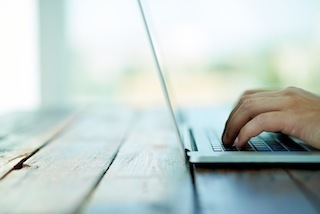 Our jobs define us, for better or worse. When we’re out at a party and someone asks “What do you do?” we don’t talk about our love of Eastern European history or our kite-flying or the workout regimen we’ve recently put together. We talk about how we make money – our job, our work – probably because it’s only natural to focus on the activities that allow us to eat, have a roof over our heads, and stay relatively clothed. But it’s also because work is the single biggest time sucker in our lives. The average American adult with kids and a job spends nearly 9 hours per day engaged in work-related activities, more than time spent sleep, leisure, or eating.
Our jobs define us, for better or worse. When we’re out at a party and someone asks “What do you do?” we don’t talk about our love of Eastern European history or our kite-flying or the workout regimen we’ve recently put together. We talk about how we make money – our job, our work – probably because it’s only natural to focus on the activities that allow us to eat, have a roof over our heads, and stay relatively clothed. But it’s also because work is the single biggest time sucker in our lives. The average American adult with kids and a job spends nearly 9 hours per day engaged in work-related activities, more than time spent sleep, leisure, or eating.
What if you could cut down on that portion of your day while retaining your productivity? What if you could hold down a corporate gig while in your boxers and from the comfort of your own home?
What if you could telecommute?
Last week I wrote about the high costs of commuting, and briefly touched on telecommuting as a viable solution to the time suck that is driving to and fro for five days a week, every week, year after year. Let’s explore this one a bit more.
For most people, the prospect seems impossible, but don’t give up so easily. Telecommuting is growing more common. As of 2012, one in five workers worldwide telecommuted some of the time and almost 10% worked remotely all the time. That same survey found that only 21% of jobs logistically required that workers be in the office every day – so it’s definitely possible for more, maybe most workers to telecommute at least some of the time.
Let’s start with a disclaimer: not everyone should telecommute. Certain jobs lend themselves well to telecommuting. Some do not. You can’t really do construction from your house, or give massages. Not everyone wants to telecommute. Millions of people are perfectly happy with their current work arrangement (millions more are perfectly miserable, of course). If that’s you, don’t think you’re missing out.
You might learn something all the same, though.
So why should you telecommute? What are the benefits?
It makes going and being Primal easier. I receive a lot of emails from readers having trouble incorporating some aspect of the Primal lifestyle into their lives. That’s to be expected. It’s a big change from how people commonly live, eat, and exercise. But the people who have the most issues are the office workers putting in long hours and enduring long commutes. Having to sit in place for eight to ten hours a day puts a real damper on eating and moving well. Who knew?
When you work from home – or your favorite cafe down the street – you are beholden to no one. You can be as weird as you want. You can wear what you want. You can work at your own pace (depending on the nature of the job). Like any animal, humans want to be free, and telecommuting gets you a little closer to that ideal.
You can actually cook. You can get dinner ready in between calls and make real lunches so you’re not reliant on whatever restaurants are within rush-over-when-you-have-ten-minutes-to-spare-and-grab-a-quick-bite-to-wolf-down-at-your-desk distance of your office.
You can sneak out to the garage gym or your building’s fitness center for a quick workout when you need a recharge and there’s a lull in work. Exercise can be incorporated throughout the day, rather than relegated to a single, unpalatable chunk of time at the end or beginning. This is an arguably better way to “exercise,” as it promotes the kind of constant activity humans have (pre)historically engaged in.
You can get more natural light. Bright, full spectrum light provided by the sun might be about as effective as coffee in perking workers up. Some offices are even trying to recreate this effect by installing blue lights overhead. It’s fairly effective at actually increasing worker alertness, but the real thing from the sun is going to be better.
You can get sun. Afternoon sun, which provides the best balance between UVB and UVA, is the best way to get the requisite vitamin D, but that’s usually when we’re stuck in a meeting or hunched over our computer inside a cubicle. Working out of the office, you can get sun at your leisure.
You can work outside. You may have read my post years ago discussing the benefits of working outside and thought to yourself, “Well, wouldn’t it be nice if my office had an outdoor space?” If you telecommute, you can have all the outdoor space you want.
You can take frequent breaks to disrupt the sitting without looking over your shoulder. Sitting is a killer. It inhibits fat burning and increases all-cause mortality independent of whether you exercise or not. Sitting also makes your hips tight, your glutes weak, and impairs your overall joint health and mobility. By breaking up your sitting with frequent breaks, you can improve your blood pressure and postprandial blood glucose.
You don’t have to sit at all. You don’t have to lobby your boss for a standup or mobile workstation; you simply set one up yourself.
You can nap if you need one. Naps improve productivity and increase happiness, but not so much if you have to duck beneath your desk away from prying eyes to do it (unless you’re a sociopath with absolutely no shame). Telecommuters can nap when there’s downtime.
You get more time with your kids. If they could choose, most parents would spend more time at home with their kids. If your employer allows it, telecommuting gives you that choice, while traditional employment removes it. And if you don’t have kids, you get more time with yourself. That’s also a good thing.
You don’t have to physically commute. This saves you a little – or a lot – more time that you can spend doing things you like, like sleep. Try not to use the extra time to just work more.
Telecommuting lowers work-to-family conflict. A major source of conflict in a household is work. If you’re gone all the time, or burnt out from working so much, fuses shorten, tempers flare, and conflicts arise. You spend more time recovering from work than enjoying the quality time with your family that a relationship requires to work. But research shows that telecommuters enjoy lower work to family conflict, and the more you work at home, the bigger the improvements.
Telecommuting improves productivity. This isn’t true for everyone who telecommutes. We all work at different capacities in different contexts. Some people thrive with the whip at their backs. Others prefer more autonomy. If you’re one of the latter, you’ll excel at remote work.
Telecommuting makes you feel better about yourself and your work. A recent study of traditional commuters and remote workers found that telecommuters report the greatest satisfaction, lowest stress, and highest sense of well-being. I think we could all really go for some of that.
Okay. You’re sold on the benefits and you’d like to make this happen. How?
Ask. You might just have to bite the bullet and ask. As long as your work is solid and you’re in good standing, it shouldn’t hurt. Don’t be afraid to point out that you telecommuting may save the employer money on insurance, office space, and equipment, too.
Be prepared. Make sure you have everything you need at home to make telecommuting work: a solid Internet connection, video conferencing capabilities, a good laptop, etc.
Be a parent. A recent study suggests that employers are more likely to grant telecommuting privileges to employees with children. If you tell your employer you want to work from home for other reasons, they may be less likely to grant your request.
Find a new job or create your own. A surefire way to telecommute is to get a new job that allows it or strike out on your own. Become a contractor a freelancer or an entrepreneur. Or heck, get Primal Blueprint Expert Certified and turn your passion for the Primal lifestyle into a career.
When applying and interviewing for new jobs:
Look for jobs that mention “remote work” or “telecommuting” in the job description. That’s a sure bet you’ll be able to do it.
Research a prospective employer’s policies. Popping over to Google and entering “[company] telecommuting policy” will usually do it.
Browse Glassdoor. Glassdoor is a site where employees (both former and current) can give company reviews, report salaries, and discuss interviews; it’s invaluable for anyone interested in a particular company from an employee’s perspective. Reviews often contain explicit information about a company’s telecommuting policies.
Ask about telecommuting after receiving but before accepting an offer. Some people suggest asking about a company’s remote work policy during the interview. I’d be okay with that from a prospective employee, but other employers might not. To be safe, get the offer first and then ask about working from home.
Negotiate. If working from home is really important to you, consider giving up a perk or a little salary. Don’t worry, you can probably get it all back once you’ve proven they made the right choice.
There are a few things to keep in mind when actually telecommuting.
Maintain regular hours. I don’t mean you have to work from 9 to 5. Work 12 to 8. Or 8 to 12 and then 3 to 7. Normal business hours aren’t necessarily necessary. But allocating specific chunks of time to work and for breaks – and being strict about it – will make you more productive and, maybe more importantly, limit the intrusion of work into your every waking moment.
Beware workday creep. For some employees, telecommuting just leads to the expansion of hours (PDF). Since most telecommuters aren’t exclusive – they also work in an office – allowing remote work becomes a way for employers to get employees working longer hours. “Oh, sure! We totally support telecommuting!” They give you company laptops and smartphones with the expectation that you’re always on call. If you’re okay with that and you know what you’re getting yourself into, fine. Just be wary. Set boundaries.
Realize you don’t have to work at home. You can go to a cafe; some research even indicates the din of a busy coffee shop actually increases productivity. You can go the park or the library. An increasing number of formal co-work spaces designed for telecommuters are popping up all over, like San Francisco’s Citizen Space, New York’s NeueHouse, and LA’s Blank Spaces.
Eliminate distractions. Get in, get out. Don’t dawdle on Facebook. Use some or all of the productivity tools mentioned in this post. The Worker Bees are particularly fond of Self Control (for Mac) and Stay Focused (for Chrome), which keep you from visiting sites you know to be time suckers.
Keep Twitter closed. You can check Twitter, especially if it’s important for work. But don’t leave a tab open or even visible on your screen. I have a bad habit of keeping Twitter open in a tab. And sure enough, every other second or so there’s an update – a little number in parentheses pops up and I just have to see what people have posted. And by the time I’ve scrolled down to read all the tweets, there are ten more.
Do great work. If there’s one way to keep your boss happy with the arrangement and allow you to continue the telecommuting arrangement it’s to become invaluable by producing great work.
If you make it work and do it right, telecommuting can really pay off – for both you, your work, and your employer. I strongly suggest exploring it as a possibility. Several of my workers telecommute, including my general manager in Sydney, Australia and a Worker Bee in the San Francisco Bay Area. With the right people, it works.
What about you guys? Any telecommuters out there care to share tips? How did you make it work?
Thanks for reading, everyone!
Further Your Knowledge. Deepen Your Impact. Become an Expert! Learn More About the Primal Blueprint Expert Certification




September 1, 2014
Dear Mark: Unschooling and Letting Your Freak Flag Fly
 Today’s edition of Dear Mark has a theme: being a Primal freak and proud of it. First up is a question about the Primalness of unschooling, a learning method that isn’t really a method and challenges everything most people think they know about education. Since hunter-gatherers didn’t attend schools, instead learning about the world by living in and being curious about it, does it follow that modern children can also learn effectively without formal education meted out by an authority? I think so. And then I help a reader discover the joy of reveling in one’s strangeness. You’re weird, I’m weird, we’re all weird. Everyone else is going to notice it, and that’s more than okay.
Today’s edition of Dear Mark has a theme: being a Primal freak and proud of it. First up is a question about the Primalness of unschooling, a learning method that isn’t really a method and challenges everything most people think they know about education. Since hunter-gatherers didn’t attend schools, instead learning about the world by living in and being curious about it, does it follow that modern children can also learn effectively without formal education meted out by an authority? I think so. And then I help a reader discover the joy of reveling in one’s strangeness. You’re weird, I’m weird, we’re all weird. Everyone else is going to notice it, and that’s more than okay.
Let’s go:
Hi Mark,
I read with great interest all your books, articles and periodically the blog. It is all amazing. I am from Argentina and live in Austria.
I just could not find much in your website about the concept of unschooling and homeschooling and I believe it to be very pertinent to the primal ancestral discussion, especially in relation to the notion of play, following more natural move patterns, and overall how modern schools shaped around an utilitarian factory like economical model, have only a few hundred years old, as opposed to millions of years humans learning different (such a time analysis reminds me of the notion that agriculture is very new vs what we eat through evolution).
Hope you find this theme interesting to address. Thanks in advance if you do so.
Matias
Although we didn’t do it with our kids, unschooling intrigues me. It makes sense. Kids are curious about everything. They’re frequently in awe. They like learning. They become miniature experts of pet subjects, throwing their entire being into the diligent pursuit of everything there is to know about dinosaurs or trains or archaeology or butterflies. Anyone who’s ever had one or interacted with one can tell you that. Even the kid with her head buried in an iPad is curious about something, or would be if you gave her a chance.
Unschooling capitalizes on that natural zest for learning inherent to tiny humans. Unschooling parents don’t teach their kids, not directly. They act as resources and guides to support the child’s curiosity. They provide transportation (to museums and forests and meetups and libraries) and resources (books, supplies, logistics) and answers to questions, but they’re not putting together lesson plans or following a teaching template. The kids set the agenda and the adults try to stay out of the way. There are subgenres of unschooling (like radical unschooling where kids receive absolutely zero input), but that’s the basic gist of it as I understand.
Peter Gray, one of the major experts on the role of play in human evolution and consciousness, is a huge proponent of unschooling. He echoes the very point you make, Matias: that what we call unschooling is actually the oldest system of human education. It’s an organic model arising out of the human animal’s natural curiosity about the world, not a bureaucracy; it’s the most likely way humans have learned for most of our history; and it’s how current hunter-gatherers – an admittedly rough approximation of our ancestral past – still learn today.
But I’d be careful. Unschooling isn’t “easy.” It can go wrong.
Consider the original unschooling environment: the wild world. Thousands of animal species. Tens of thousands of bug species and plant species. Dirt, sun, water, fresh air, things to climb, things to crawl under and into, places to dig, something new to see and find every single day. New challenges to face, most of them relevant to the challenges they’d see as adults. Kids of all ages, usually unsupervised.
Now consider the typical unschooling environment today: the inside of some house, maybe a park on certain days. The same furniture and climbing equipment every day. The same flat, even walking surfaces. Predictable activities and challenges. Very few real surprises, not much carryover into the outside “real” world. Scattered kids, usually protected by hovering parents.
I’m not suggesting that unschooling can’t work in the modern world, but for it to approach the effect of the ancestral unschooling environment you have to leave the house and expose the unschooled child to new, varied stimuli and challenges. Since we no longer live in close-knit tribes or large extended families, the unschooled child also needs a community of peers.
If Carrie and I could go back and do it all over again with our kids, we might incorporate some unschooling in the mix. But you know what? Unschooling isn’t the only way to produce a healthy, happy, engaged human, and a traditional school education won’t necessarily create a hard-working clock-punching automaton. Our kids, who went to fairly traditional schools, are turning out to be great adults. Lots of friends, curious about learning new things and seeking new experiences, healthy habits. We’re very proud.
Whatever style of education you settle upon, help your kid cultivate curiosity. You don’t even really have to do anything except put your kid in interesting situations and let it happen naturally. Lead interesting lives and keep interesting objects and reading material and art around. Have music on often. Play music, too. Take your kid to the forest, beach, desert, and museums. Have interesting friends over for dinner; if they have kids, even better.
Start early. Start immediately. Those disproportionately-sized baby brains are sucking up information from the get go. The sooner they’re exposed to environments of learning and knowledge acquisition, and the more their parents and peers are curious about that world, the more they’ll want to learn. And it will stick, because it’s been there all along.
Dear Mark,
I’m really having trouble keeping to the lifestyle that you suggest. I’ve been off and on the wagon in terms of diet and exercise, and I don’t know how to keep on track. The hardest challenge has been because all of my friends or family think I’m a freak. It makes me feel kinda lonely. What can I do?
A few weeks back, another reader asked a similar question about constantly falling off the wagon. She’d be strict for a couple weeks only to end up binging on junk food. Like clockwork, this happened every other week. My advice was to change her perception of those junk food days. Since they were going to happen anyway, thinking of them as “part of the plan” eliminated the stress and psychological fallout. It wasn’t failure; it was compromise. So that might work for you, but it might not. I suspect not.
I’m sensing that your real issue with all this is feeling alone. Like a “freak,” as you say. Believe me, I get it. Being Primal can make you an outsider, especially early on when you’re the guy who suddenly stops eating grains and sugar. Much of what we do runs directly counter to the norms. That scares people:
Everyone’s chowing down on pizza and you’re there with your salad.
You’re the only guy without expensive hiking boots on the trail. You might not even be wearing any shoes at all.
At lunch in the break room, you self-consciously eat leftover grilled ribeye with steamed broccoli and butternut squash mash amidst a sea of Subway and frozen dinners.
You politely pass on the birthday cake and double up on fruit.
You’re at the track, running sprints and earning strange looks from joggers.
You’re trying to plan dinner parties while your peers are still into late nights at the bars and clubs.
Sound familiar?
First off, don’t be a jerk about being Primal. Don’t make a face when they ask for fat-free dressing. Try not to sneer when someone squats in the Smith machine. Don’t wear Vibrams to the wedding. If a person challenges your grain-free and high-fat ways, go ahead and respond with sound, measured arguments; don’t belittle them. No one is beneath you. Make sure you’re not the one making people feel left out before you go blaming them. I doubt that’s the case, but I have to rule it out.
It’s tough, especially if you’re younger. And sadly no, it’s not just “in our heads.” Either you’re making them feel bad for eating junk or not exercising and they lash out, or you’re challenging the paradigm upon which their reality rests and they can’t deal with it. Some people really do look down on us for eating, exercising, and living differently. No one likes that feeling. No one wants to be ostracized by friends and family or the general public.
There’s really only one way to beat it: you have to let your freak flag fly. You just do.
I’m proud to be a freak in my own way. But extensive life experience residing firmly outside of the mainstream on many issues has made me comfortable there. At this point, I feel weird if I’m doing what everyone else is doing. You can get here, too, and you should. It’s a wonderful state of existence - being comfortable in your own skin.
But I’m not doing it alone. Beside me are my family, my friends, and this entire community of loyal, curious readers who also happen to be freaks in their own way. That makes it easier.
Whenever someone expresses feelings of exclusion, my thoughts turn to PrimalCon. For regular attendees, it’s a tribal gathering, a family reunion. For many first timers, PrimalCon is the only time they’ve felt at home. I know this because they tell me. They come up to me, or one of the team leaders, and gush about finally feeling like a part of something bigger. And you see it happening all throughout the weekend: a tribe of freaks forming, accepting new members. It’s a beautiful thing, and it sounds like precisely what you need.
You gotta find your tribe. You can’t do this alone.
Thanks for reading, everyone, and have a great start to your week.
Further Your Knowledge. Deepen Your Impact. Become an Expert! Learn More About the Primal Blueprint Expert Certification




August 31, 2014
Weekend Link Love – Edition 311
 I recently returned to the The Paleo View podcast to hang out with Stacy and Sara and talk about a bit of everything. Go have a listen.
I recently returned to the The Paleo View podcast to hang out with Stacy and Sara and talk about a bit of everything. Go have a listen.
I also paid a visit to Extreme Health Radio, where I talked about the importance of cultivating play in our lives, building muscle on our bodies, and much more.
Research of the Week
Stress inhibits calorie burning; calmness enhances it.
As humans doubled our population over the past 35 years, invertebrates lost almost half of theirs.
Bright light exposure in the morning was enough to lower body fat and appetite in obese women.
Interesting Blog Posts
The British Medical Journal has just reprimanded one of the UK’s top statin advocates and cleared the arguments of the statin critics he so desperately railed against.
Media, Schmedia
When it comes to cardiovascular health trials, study participants don’t reflect actual real-world patients.
To give kids and teens more sleep, the American Academy of Pediatrics just issued a policy statement recommending that schools start no earlier than 8:30 AM. Bravo.
Everything Else
This sounds familiar.
The fascinating story of a real American hermit.
Between pitcher’s shoulder, fractured ribs, a massively muscled frame, and a spearpoint lodged in his hip, this American from 9000 years ago was one tough bastard.
Fish and poultry farmers might start feeding insects instead of soy. That’s a huge step in the right direction.
What (little) we know about Denisovan man.
Some people just have a genetic need for less sleep.
I don’t know that all of these are definitive answers to the biggest health questions, but some of them get it right.
A chef dropped his camera into boiling water not accidentally but to film a poaching egg.
Try this Beautiful Practice movement sequence from Frank Forencich tomorrow morning – or right now.
Look at this glorious wombat.
Recipe Corner
Gorgeous, .
Keto tiramisu.
Time Capsule
One year ago (Aug 31 – Sep 6)
This Gluten-Free Thing Is a Really Overblown Fad! – Are we all just experiencing a collective delusion, or is there actually something to gluten avoidance?
The Impact of Loneliness – We’re social beings. Ignoring that aspect of ourselves is bad for our health and happiness.
Comment of the Week
I gave up my 15 year old brick and mortar business for a lower paying gig working from home back in March and couldn’t be happier.
The commute is pretty tough though. Ran into a traffic jam this morning on the way in… cat was in the hallway.
- Google really needs to start mapping cat traffic.





August 30, 2014
Cauliflower Muffin Bites
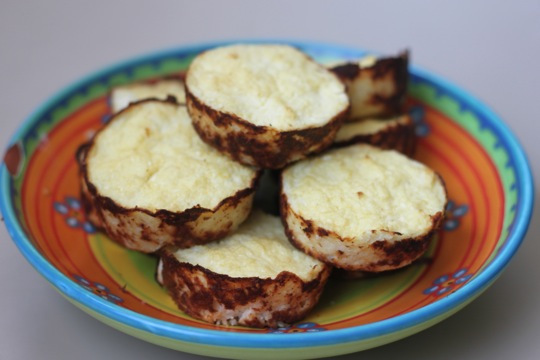 If you’ve ever tried to make a cauliflower pizza crust and liked the flavor but not the soggy doesn’t-really-hold-together texture, then cauliflower muffin bites are the way to go. Easier to make and much more likely to hold together, these mini muffins make a nice snack, side dish or appetizer.
If you’ve ever tried to make a cauliflower pizza crust and liked the flavor but not the soggy doesn’t-really-hold-together texture, then cauliflower muffin bites are the way to go. Easier to make and much more likely to hold together, these mini muffins make a nice snack, side dish or appetizer.
In fact, there’s no reason you can’t turn these into “pizza muffin bites” by adding grated cheese, olives and pepperoni. Think of this recipe for cauliflower muffins as a template that you can add all sorts of different flavors to.
Try:
Black olives, oregano and thyme with feta sprinkled on top
Finely chopped cooked bacon
Cheddar and jalapenos
Finely chopped and sautéed bell pepper and garlic
But don’t feel too much pressure to make the ingredient list for this recipe longer. Without anything extra added, these “muffins” are still darn good: moist, tender, and comforting.
Servings: 12 muffins
Time in the Kitchen: 45 minutes
Ingredients:
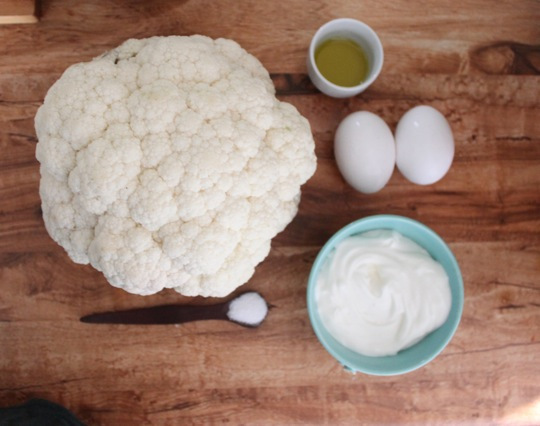
1 head cauliflower
2 eggs
3/4 cup full fat plain Greek yogurt (175 g)
1 tablespoon olive oil (15 ml)
1/2 teaspoon salt (2.5 ml)
Instructions:
Preheat the oven to 425 °F/220 °C. Grease or butter a muffin tin that can hold up to 12 muffins.
Cut the head of cauliflower into small pieces and pulse in the food processor until the texture is very fine, like rice. In two batches, put the cauliflower in a thin towel, gather the towel up around it and squeeze out as much moisture as possible.
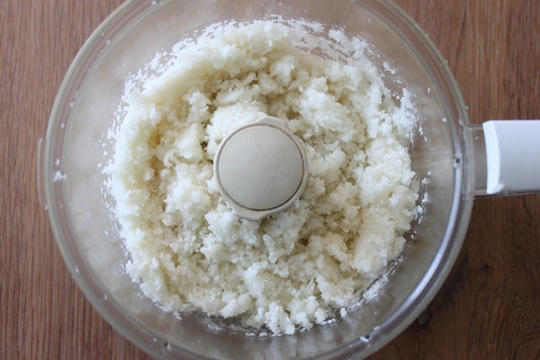
In a large bowl, mix together the cauliflower, eggs, yogurt, olive oil and salt.
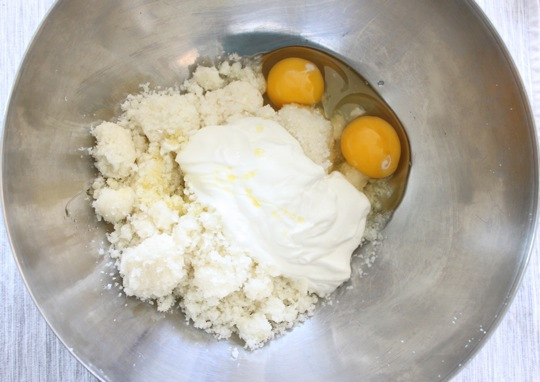
Evenly fill the cupcake tins with the cauliflower batter.
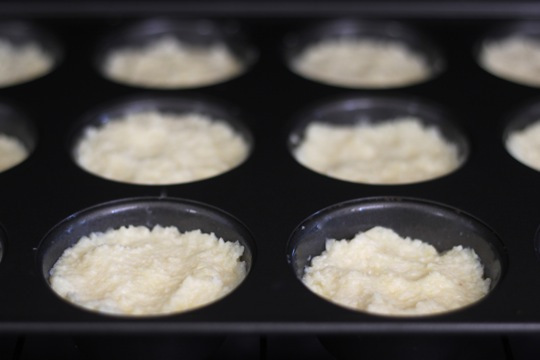
Bake for 25 minutes, until the tops are firm. Let cool completely before removing from the muffin tin.

Not Sure What to Eat? Get the Primal Blueprint Meal Plan for Shopping Lists and Recipes Delivered Directly to Your Inbox Each Week




August 29, 2014
Over 100 Pounds Lost: Things Just Keep Getting Better and Better
It’s Friday, everyone! And that means another Primal Blueprint Real Life Story from a Mark’s Daily Apple reader. If you have your own success story and would like to share it with me and the Mark’s Daily Apple community please contact me here. I’ll continue to publish these each Friday as long as they keep coming in. Thank you for reading!
 My story starts with a girl, two actually, to be accurate, and also a beloved uncle. The ladies are my daughter and my wife. After years trying to start a family, my wife and I were fortunate to adopt our daughter from foster care in 2011. At that time, and for most of my adult life, I had been morbidly obese between 250 and 300 lbs at 5 foot 9. I’d like to say that becoming a parent, as amazing and life-changing as it was every single day, was enough to lead to dramatic changes to my daily eating and exercise habits, it wasn’t. I felt an increased need to be healthy to contribute more on a daily basis to my wife and daughter, yet still things went on as before. I was in a health netherworld of no major illnesses but not what I would describe as vitality of any sort. I certainly was not thriving. I was living what I understand now was a diminished life, both physically and mentally.
My story starts with a girl, two actually, to be accurate, and also a beloved uncle. The ladies are my daughter and my wife. After years trying to start a family, my wife and I were fortunate to adopt our daughter from foster care in 2011. At that time, and for most of my adult life, I had been morbidly obese between 250 and 300 lbs at 5 foot 9. I’d like to say that becoming a parent, as amazing and life-changing as it was every single day, was enough to lead to dramatic changes to my daily eating and exercise habits, it wasn’t. I felt an increased need to be healthy to contribute more on a daily basis to my wife and daughter, yet still things went on as before. I was in a health netherworld of no major illnesses but not what I would describe as vitality of any sort. I certainly was not thriving. I was living what I understand now was a diminished life, both physically and mentally.
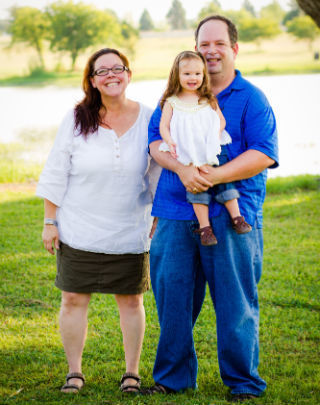 But more changes in my life, beyond becoming a parent, were in store. My uncle who was my dad growing up developed dementia and my wife and I became his sole caregivers in December of 2012. He also had diabetes as did his mom who lost a leg and eventually her life to diabetic complications. Taking care of him, having two full time jobs, and raising our daughter took every ounce of our time. If anything I was gaining weight at this time, profoundly saddened at my uncle’s condition but just trying to stay afloat. So I limped along, becoming in many ways more diminished. Did I see my future in my uncle? Yes. Did I know what to do? No.
But more changes in my life, beyond becoming a parent, were in store. My uncle who was my dad growing up developed dementia and my wife and I became his sole caregivers in December of 2012. He also had diabetes as did his mom who lost a leg and eventually her life to diabetic complications. Taking care of him, having two full time jobs, and raising our daughter took every ounce of our time. If anything I was gaining weight at this time, profoundly saddened at my uncle’s condition but just trying to stay afloat. So I limped along, becoming in many ways more diminished. Did I see my future in my uncle? Yes. Did I know what to do? No.
In May of 2013 I attended a trade fair that happens once a year. I hadn’t worn a particular jacket since the previous year. It was now around three to four inches too small, it did not fit over my increasing belly. I was also beginning to not even fit into XXL shirts anymore. A few days after the jacket not fitting I was at a concert. I looked around and I was one of the biggest, maybe the biggest person there. It just felt absurd. But even more than that it felt, with a tremendous force, was unacceptable. At my core I felt it was no longer an option for me to be unhealthy, for me to burden my wife and child with a husband and father suffering from dementia. Especially to burden my daughter who would be in her early 20s, just starting life, when I reached the same age at which my uncle developed dementia. I also felt hopeful and certain I would succeed. Everything had built to a point where I had changed inside. Whatever alchemy had occurred to lead to that moment, at that concert I felt hopeful not hopeless, I knew I “had this.”
Because when I looked around I not only saw that I was one of the biggest people there, but for those people I saw which were at a healthy weight, I knew they did not have any ability that I did not possess to understand nutrition and live a healthy life. I had accomplished many things in my life, except being physically healthy. But I knew this time would be different. And my many successes besides my weight gave me confidence that I would be successful. With motivation I knew anything was possible.
The day after the concert I started my weight loss journey the old fashioned way, I turned to the Internet and Twitter. I had one key thought running through my head: it wasn’t just me. When I looked around, the communities I lived in seemed to be getting bigger, sicker, and less healthy. I thought how could that be if what I was being told was the way to health was true? I also started with a key personal observation. My wife thought I was an emotional eater. But I knew I was just always hungry. My reality was of constantly being hungry. And what struck me most was the hunger I would experience within just a couple of hours of eating a huge fast food meal.
My first Internet search was something like “Why am I so hungry so soon after eating a large fast food meal?” I quickly came upon discussions of insulin, its key role as one of the most important hormones, fat storage versus fat burning, blood sugar and hunger. Having my family history of diabetes and having blood work indicating it was a likely outcome in my near future, this information fully captured my attention. I then acted. I stopped buying bread and pasta. I also cut fast food cold turkey. I stopped buying potato chips and candy bars. Potato chips were particularly hard as they were not only my favorites, but my most addictive snack. I could easily consume a five ounce bag in one sitting. In fact, it was very hard, often impossible, for me not to consume the entire bag in one sitting, feeling guilty with every crunch.
I didn’t have a fully coherent plan at this point and hadn’t yet even heard the terms Paleo and Primal. Having diabetes on my mind though, I was determined to stay away from starches. I even thought “gluten intolerance” was made up at the time and people eliminating wheat were hypochondriacs. But I knew diabetes was real and within a week or two I saw dramatic reductions in my appetite. Because my motivation for myself and my family, and yes my fear for my future, were so high any cravings I experienced I just powered through. In my particular journey, giving up my daily staples wasn’t as hard as I thought. Whatever combination of motivation, physiology, and happenstance were responsible, I am grateful for that. Of course it is one thing to decide not to eat something but I then had to figure out what TO eat.
It might be helpful at this point to point out some of the health issues I was dealing with at this time, in the summer of 2013. I could barely fit in to XXL shirts anymore and some were too small. My waist was 48 inches. I had severe sleep apnea and severe, daily allergies. I took allergy medicine daily and had to miss work at least five days a year when the allergies were overwhelming. I had back pain and debilitating cramping that often occurred after eating a carb heavy meal. I could walk without pain and play doubles tennis without pain but could not run more than ten seconds.
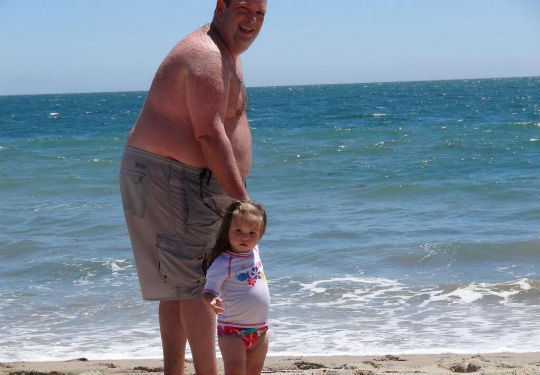
As happens with Internet and Twitter searches, they led to links and videos and I happened upon a YouTube video of Professor Tim Noakes. Professor Noakes is a prominent South African scientist, who also had a health crisis and is now a low-carb, high-fat advocate. He was discussing his personal story and a man I had never heard of, Ancel Keys. He was referencing the six and seven country studies. Something called the diet-heart hypothesis. I remember these two slides being displayed. One was an almost perfect curve of six countries showing a correlation between saturated fat consumed and rates of heart disease. The second slide was the twenty-two countries he had data for that showed no correlation whatsoever. I was lucky enough to have had enough science education that the idea that correlation does not prove causation was second nature to me. So too were the concepts of confirmation bias and cherry picking data.
That video was a “gateway” to finding many other resources that most reading this are no doubt very familiar with: Gary Taubes, Dr. Perlmutter, Tom Naughton, and eventually Paleo, Primal, and Mark’s Daily Apple. I started to have a coherent vision of what had gone so wrong the last 40 years for my family, for America, for global society. I remember another key search I did: Why is going grain free good? A novel concept to me at the time beyond their impact on glucose. I think that search, in fact, led me to MDA. It was the humorous article Mark had written on answering questions from friends on why you are grain free. The sandwich discussion was just brilliant. The information in that article correlated with so many other articles and what I was experiencing in my own life.
What really cemented my intellectual journey was the elegance of everything I was finding out. I had always been fascinated by evolution, spending my baby sitting money on every book the late Stephen Jay Gould published. The central concept I was coming across was that human beings thrived when they eat a diet that their genes had been selected for. It just fit, it felt right. And I was shocked that literally every dietary “truth” I had been told, every nugget of conventional wisdom so confidently told to me by every doctor I had ever talked to, was wrong.
This intellectual journey took many months and continues every single day. I don’t think I came across the MDA article on grains until late 2013. By that time I had continued not having a single fast food meal, no junk food snacks, no bread, and no pasta. I was also attempting a couch to 5K program or C25K, in the Texas summer heat. Growing up, I had been known as “Cherry” Diamond during every Presidential fitness run I attempted. I had never been able to run. In retrospect this was probably very much impacted by my life situation growing up. I grew up in Los Angeles and was thankfully extremely active. But I was completely disconnected from any home food tradition whatsoever. I was an only child in a single parent household. My mom herself had never been taught to cook. I grew up on boxed cereals and TV dinners. It is, sadly, no exaggeration that the closest I had to a home-cooked meal growing up was hamburger helper. My body developed on school lunches, junk food, and fast food. Any cooking that happened in the house, I was responsible for. Thankfully omelets were one of, okay my only, specialty. But my daily food intake was not good, to say the least.
My body did the best it could under the circumstances, but apparently running was asking too much of it for as long as I could remember. Nonetheless, even though still in the 270s, in late summer of 2013 I was determined to become a “runner.” I made two extremely helpful decisions. I bought a very good pair of running shoes and I decided to repeat days and weeks as often as I needed to on the C25K program. If it took me six months to complete the program instead of eight weeks, that was fine with me.
At first it wasn’t much fun. And I had a calf injury from tennis that had me restart from the beginning. But by the beginning of 2014 running was almost becoming fun. Actually it WAS fun. I had gotten down to the 230s by this time and I was feeling incredible. Movement at work had become a joy. People were giving me compliments all the time on how good I looked. Now I was still a 5’9” 230 pound guy. But hey, I wasn’t a 5’9” 290-300 pound guy. I was really pushing my wife (who also needed to lose weight and get healthy), letting her know how great this was. Especially how I was no longer hungry. At the time I was pushing her too hard.
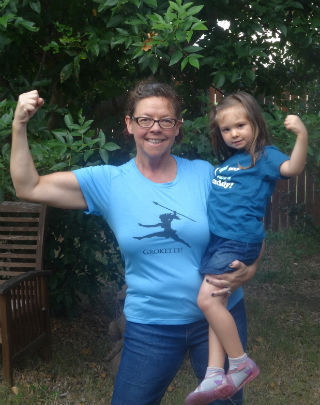 Nonetheless she started her own low-carb/high-fat journey at the beginning of 2014. Like me, she had to be ready and motivated. I think it was because we had visited her father over the holidays and all he could talk about was how good I looked. I think my getting healthier had brought out all the unspoken fears he had for the health of both of us. Whatever the combination of reasons, I am so happy my wife has embarked on this journey as well. And she has been equally successful. She is enjoying the most vibrant health of her life, has dropped over 50 lbs and over 10 dress sizes since the beginning of 2014.
Nonetheless she started her own low-carb/high-fat journey at the beginning of 2014. Like me, she had to be ready and motivated. I think it was because we had visited her father over the holidays and all he could talk about was how good I looked. I think my getting healthier had brought out all the unspoken fears he had for the health of both of us. Whatever the combination of reasons, I am so happy my wife has embarked on this journey as well. And she has been equally successful. She is enjoying the most vibrant health of her life, has dropped over 50 lbs and over 10 dress sizes since the beginning of 2014.
And things were just continuing to get better and better for me. I completed my first 5K February 1, 2014. At around 38 minutes I met my goal, which was to run from start to finish. A couple of months later I ran my second 5K and my time was 31 minutes. I was starting to use MDA more and shifted into more of a “Primal Fitness” regime. I still ran and walked but I did more strength exercises and started to sprint in the summer of 2014. I also started listening to MDA podcasts and heard one from Darryl Edwards on Primal Play with Brad at Tulum. One day recently I was at a park and saw a bar in a playground just about the perfect height for a pull up. Never in my life had I been able to come close to doing a pull up. I thought what the heck, what would Darryl do? And getting my chin over the bar was one of the best feelings of my life.
 So what does my health and life look like now? I am in the high 170s, a weight I haven’t been since high school or below, and I hope to lose another 10 to 15 lbs. My sleep apnea and allergies are completely gone. I haven’t had to take an allergy medicine in months. I haven’t gotten sick once, in over a year. My back pain went away completely after I gave up my last grain, corn. I have sustained mental energy. My relationships are better. I feel more joyful. I feel centered and solid in ways I never even knew existed before this journey started. My daughter is thriving on a no gluten, high fat way of eating. When I look at my wife and see her health and vibrancy it feels me with joy.
So what does my health and life look like now? I am in the high 170s, a weight I haven’t been since high school or below, and I hope to lose another 10 to 15 lbs. My sleep apnea and allergies are completely gone. I haven’t had to take an allergy medicine in months. I haven’t gotten sick once, in over a year. My back pain went away completely after I gave up my last grain, corn. I have sustained mental energy. My relationships are better. I feel more joyful. I feel centered and solid in ways I never even knew existed before this journey started. My daughter is thriving on a no gluten, high fat way of eating. When I look at my wife and see her health and vibrancy it feels me with joy.
Primal food has been a revelation in taste. Now food is not dominated by sweetness, and the artificial and chemical. There are an array of subtle flavors I savor now. We eat only whole foods, which was a much easier transition than I expected. We made them the only things in our pantry and there are just as many quick and easy whole food options as there were for processed foods. The per ounce price of high quality whole foods is often less than low quality processed foods, and they are much more filling. Going Primal has also reinvigorated our cooking as we use new ingredients like collagen and bone marrow. And I have just two words for everyone that’s lactose tolerant: heavy cream. A total revelation for a former skim milk drinker. We’ve found good sources for high quality lard and tallow. Those, along with coconut oil and butter, have become our home cooking oils. We eat out much less because it is extremely hard to find a restaurant that doesn’t cook with industrial vegetable oil and we definitely notice when they have been used. There are tremendous Paleo, Primal, and gluten free recipe resources everywhere you turn. People are eager to share in our communities.
I’ve come to enjoy the differences in various grass fed butters, and the richness, textures and notes of flavor of high quality cheeses. 85% dark chocolate has so many more layers and enjoyment than the sugar dominated chocolate I used to have. For us it isn’t about 80/20 as we enjoy the food so much and feel lousy eating processed foods and grains, especially anything with gluten. So there is no deprivation, and beyond that, foods actually taste better without grains. I’ve never enjoyed burgers more than without the bun. If it is a good burger, why would I want a bun to get in the way? Grains, and this is no rationalization at all, are among the least tasty foods I’ve ever known. Grass fed meatballs and excellent sauce? Sign me up. We have taken to heart the saying “Don’t let perfect be the enemy of the good.” We seem to do OK with potatoes and cooked beans, so we have both here and there. I also seem to do well on unmodified potato starch, and as far as I can tell my microbes like it. Recently I haven’t felt hungry at breakfast so I’ve skipped it sometimes. But I’m letting my body be the guide.
One mainstay has become good quality grass fed ground beef. It is cheaper than steaks, easier for our daughter to eat, and can be prepared in endless ways. We also can mix some liver in to where you can’t really taste it, which also helps with our daughter. I got that tip from Chris Kresser. There are a variety of good quality flours of all kinds available at most of our local stores for the occasional baking. To get a nice bread like coating on say a pork chop or chicken thigh, we crush chicharrones.
My fitness routine is always evolving. But it does not involve a gym at present or during my weight loss. I’ve found body weight exercises to be very fulfilling and enjoy the compound nature of the exercises. I do have a kettlebell and I am installing a pull up bar. But mostly I do pushups, sit ups, burpees, planks, squats, etc. Recently inspired by the concept of play I’ve been having my daughter help in fitness. She is around 30 lbs, so she’s excellent to lift and otherwise engage in play/exercise. We both enjoy the interaction. Games in the backyard are play, bonding and fitness combined. I still run but find that I do just as well with a week or two off as when I was running three times a week. I’ve been sprinting, but even when being cautious it is definitely more challenging than running in terms of not pulling something. So I am easing into it now. After having a big body all of my life I want to be on the lean side and as functionally strong as possible. I hope to be climbing trees with my daughter when she is old enough to be climbing. That would be strong for me.
Although this isn’t a fitness routine, I have been using a stand up desk at work the past few months. After a transition period it has been fantastic. It has helped with core strength and posture, but also increased productivity. The hints on MDA on how to use stand up desks for maximum benefit and minimum downside have been very helpful.
Friends and colleagues have had many questions. I have helped many and I am doing a presentation at work soon. I have had a few Internet articles written about me, and Sam Feltham of the Smash the Fat fame interviewed me.
Living in Austin now, my family and I family attended PaleoFx for the first time this past year. I’ve signed up for PrimalCon Oxnard. I am so excited to not only meet everyone and soak up everything I can, but to also spend a few days back in what will always be home. The Pacific was a huge part of my life growing up. Going back to play in her is just an added bonus to what I am sure will be an amazing adventure.
What does the future hold? First it was important for me to heal myself, for me to get healthy. Then I needed to help to bring health to my family. But that is not enough. Not nearly. My wife is an elementary school teacher and the food issues central and dear to the MDA community impact her on a daily basis. Too many children, and I was on governmental assistance growing up as well, are being fed food that impedes their mental and physical development. Full fat dairy is literally banned in most schools as unhealthy and chocolate skim milk is allowed. The consequences for students and teachers are not only devastating, but entirely preventable. I am determined to fight this good food fight for the rest of my life in as many ways as I can. However I can help to bring full fat dairy to schools, I will do.
One of my big fitness goals of 2015 is to run my first Spartan race. I just recently saw video of my first Spartan and thought, “I can do this, and it looks like fun.” Of course, I have been wrong before.
One of my heroes growing up was John Denver. I consider him to be a great American poet, who also happened to be a pop singer. One of my favorite songs is Rocky Mountain High. There is a line about being born in your 27th year, coming home to a place you’ve never been before. That is what this journey feels like to me now. I have not only healed myself from the cellular level up, but my body now has the food and inputs it needs to be the ecosystem it was meant to be. I feel at home from my center, out, by following The Primal Blueprint. It is something I never would have felt any other way and something I will be always grateful for. As profound as the health benefits have been, I feel they have been overshadowed by the opportunity for me to know a more authentic me with both my body and mind operating and interacting with the world in a truer and richer way.
I am also extremely humbled by this journey. I don’t feel like I did that much. I’ve come to realize I just got out of the way of my own body and accessed the gifts that my ancestors and the Earth gave to me. My bacteria and mitochondria healed me. I simply needed to give them and my genes an environment where they were not doing damage control 24/7, but were allowed to heal me and help me live my genetic potential. Have I found that food is by far the most powerful medicine we have? Yes I have. However I can help to have as many people claim their birthright of health, vitality, and joy, I want to do. Life is wonderful now and it is with deep gratitude I thank Mark and the entire global LCHF community every day.
Further Your Knowledge. Deepen Your Impact. Become an Expert! Learn More About the Primal Blueprint Expert Certification




August 28, 2014
Why We Eat: Cravings
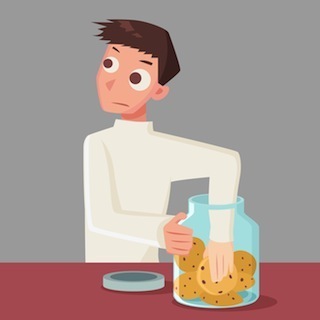 Last week I picked up the theme of hunger with an intention to visit all the angles of the instinct – the physiology behind it first – but also the outer reaches of hunger’s emotional and social sway. The fact is, I can’t think of an instinct (other than sex) that influences our evolution more or perhaps a more complex motivation. It’s one of those areas in which you can’t always separate biology from emotion. (The more you learn about the human animal, I think, the more apparent the melding of these two fields/forces becomes.) Enter cravings. Beyond the general experience of hunger (Feed me now!) are the urges toward particular foods (Need THIS now!). What exactly goes on here? What’s the real impetus behind our cravings, and what’s the ultimate pushback we can offer on the way to derailment?
Last week I picked up the theme of hunger with an intention to visit all the angles of the instinct – the physiology behind it first – but also the outer reaches of hunger’s emotional and social sway. The fact is, I can’t think of an instinct (other than sex) that influences our evolution more or perhaps a more complex motivation. It’s one of those areas in which you can’t always separate biology from emotion. (The more you learn about the human animal, I think, the more apparent the melding of these two fields/forces becomes.) Enter cravings. Beyond the general experience of hunger (Feed me now!) are the urges toward particular foods (Need THIS now!). What exactly goes on here? What’s the real impetus behind our cravings, and what’s the ultimate pushback we can offer on the way to derailment?
For many, cravings bring to mind the proverbial pregnancy tales. Back in the day, my wife and her friends would compare their pregnancy cravings with as much laughter as zeal. One woman knew she was pregnant each time simply by the ravenous craving for a hamburger from a certain restaurant. “I’ve never felt such an insistent pull toward a specific food,” she explained at dinner one night. “Come hell or high water, I was going to get my hands on that burger if it was the last thing I did.” Another friend went through several clementines a day for her entire second trimester. The cravings ran the gamut from steak to spices. (An interesting trend that beef was such a common hit, I always thought…)
Common thinking for years allowed for the idea that cravings in some cases were responses to nutritional deficiencies however subtle or dramatic. The tide seems to have shifted with most experts and studies pointing more or less exclusively to psychological and social influence. While it may not be popular opinion, I’ll admit I still leave room for the role of nutritional need as something of a factor at least in certain cases, pregnancy being one. Maybe I’m just taken in by the gratifying sight of someone enjoying a fabulous steak – its hefty iron dose aside. I do wonder, however, if those who eat a poor diet are inclined to eat more because the body knows it’s still lacking. Unfortunately, the research doesn’t drive down that road far enough at this point.
An aside… On the extreme side of craving, we see the instance of pica, in which people (particularly pregnant women) crave non-food items. While clearly there’s not much evolutionary sense in eating some of the odd items people do today who have pica (many of them things Grok and his kin had never heard of), the dirt and clay craving may not be as insane as we moderns would assume.
All this said, I think by far our experience of cravings today have to do with the power of suggestion (e.g. marketing influences) and the chemical reward that comes with certain foods. (Ah, the power of glucose…) Let’s home in on that element of craving for today.
Research has shown time and again (including MRI imaging) that the brain areas activated by cravings are the same as those implicated with drug and alcohol addiction, including the hippocampus, caudate and insula – areas that collectively tap into our memory of experience, the reward system that gives us our anticipated pleasure and the emotional association we’ll carry forward about that food (PDF).
It becomes a process of continual reinforcement (if/when we participate) as people eat what they crave, which again elicits the reward and further imbeds that reward for eating a particular food (PDF). We eat the food, and our reward circuits are going haywire all while our cognitive control mechanisms become dampened. As with alcohol and drugs, the more we eat these foods, the more the hormone receptors responsible for that rewarding sensation can become dulled. Our response? We eat more of the same/similar food to get the same reward.
While we all have our favorite foods (the result of complex memory, cultural habituation and emotional association), sugar and other high carbohydrate content food act most readily on the brain. Sugar has been likened to cocaine, and research has observed its associated neurochemical changes and the eerily matching patterns of bingeing, withdrawal, craving and cross-desensitization.
The biological fact is, we’re playing with the same fire and neuronal circuitry, and – for some of us – fighting a similarly rough battle to wrestle free of the hormonal circus (or – it’s not an overstatement for some people – hell) that takes over.
When we acknowledge the power of cravings, it’s natural to ask what our best defenses are in these situations. While our brains’ reward systems generally work the same, our responses (and perhaps even sensitivity) to cravings differ widely. I think it’s useful to consider what triggers us to begin with. Can we cut off a craving at the pass and spare ourselves an internal battle?
Research suggests all manner of strategies that seeks to manipulate our environments and exposures. When study subjects worked at an organized desk, they were more likely to make a healthy food choice at the end of the research session compared to those who worked in a cluttered environment (PDF). On the other hand, while an orderly space might encourage healthier eating overall, a seeming opposite input might help us fend off a craving once it sets in. One study shows that bombarding ourselves with visual stimuli can co-opt our brain’s bandwidth, so to speak, and reduce the mental fixation. Some research shows we shouldn’t overtax our capacity for self-control in a day even though other studies suggest self-discipline is a muscle we need to build and can continually strengthen. (I think there’s truth in both camps.) Likewise, we can apparently use a non-food smell like jasmine to “compete” for the brain’s attention and divert it from food cravings. On a simpler note, exercise, research also shows, can dull our brain’s reaction to food images.
Beyond the tricks, of course, are the common sense and maybe more holistic approaches to addressing cravings. Since I know exercise can offer its own endorphin hit, I can work out when I know I’m feeling an emotional slump or am tempted more than usual by triggering foods. Likewise, because I know sleep deprivation and stress skew hormones related to hunger and cravings, I can give my body the quantity and quality of sleep it needs, minimize exposure to stressful situations and foster emotional and physical resilience in myself. The better we take care of ourselves in general (and I don’t just mean the better we discipline and push ourselves to perform all the “shoulds”: I should eat Primally, I should exercise and move each day, I should go to bed at 10:00, etc.), I think the less vulnerable we are to the lowest common denominator of personal rewards. It’s about filling our broader needs.
When we’re stressed or agitated or feel “hooked” by the thought of a food that isn’t a reasonable response to legitimate hunger, it’s a smart thing to ask, “What do I need to do to take care of myself right now?”. Maybe my answer to that question is to get up from my desk and go for a walk. Maybe it’s to call a friend or family member. Maybe it’s to take a nap or spend some time pursuing a leisure activity instead of work.
Along a similar vein, research shows that mindfulness practice can help us “stay” with the uncomfortable feelings that often urge us to eat – particularly to eat those foods that trip our reward circuits in powerful ways. While research shows that mindful eating can help binge eaters, for example, view their taste preferences with more compassion and reduce binge behavior, mindfulness has also been studied as a way to resist cravings by those with substance abuse issues. Sarah Bowen, a University of Washington researcher, has developed a program called Mindfulness-Based Relapse Prevention (MBRP), which showed better long term results than conventional treatment models. The method teaches people to become “aware” of the emotional and physical sensations of craving, meet the experience “with compassion” and then learn to “tolerate craving and negative emotion” that commonly triggers substance use. She stresses that the underlying power of mindfulness is applicable to anyone because she views substance abuse as “another example of that too-human automatic drive to move toward pleasure and away from pain.” Applying mindfulness modality to substance abuse, she says, helps people “disengage from” the “automatic” behavior.
Given that food is an abused substance for so many people (whether occasionally or chronically/clinically), can mindfulness offer the most effective response to food craving? Can it tap into a sense of choice and responsibility in ways that make healthier eating behavior more realistic for some people? My feeling is yes, and other research (PDF) appears to suggest as much. Not only does it address underlying tendencies, but it jibes with common human behavior. It makes Primal sense. Getting real about how the human mind operates and learning to harness those innate tendencies can be considerably more effective than denying them (akin to that carnival game in which you’re always trying to smack down the spring loaded pieces that keep popping up from the many holes).
In the end, the best approach to behavior change is usually a combination of factors. Why not change our environments and exposures when we can? Do we really need to invite ourselves to temptation when we can sidestep the incidence altogether some days? Taking care of ourselves should be on the daily docket anyway, right? If we’re not doing it already, why the heck not? The fact is, the more responsibility I take for my life and health, the more I realize how much time and commitment I need to make to myself. (I have the choice to bristle against it if I so desire, but no good that comes of that grievance. I have to drop the righteousness and anxiety about not having time for myself. With time and practice, you learn to make yourself a priority without the rest of your life falling to pieces. Maybe that’s a post in itself.) It’s amazing, however, what we can unhook ourselves from when we get this self-care thing right. Finally, getting honest about what we’re really stuffing or pushing down or distracting ourselves from when we eat is critical. Releasing ourselves from the expectation and sensation of craving, for many of us, requires understanding what we’d rather not experience in its place.
Thanks for reading, everyone. What’s been your experience with craving? Where does the science make personal sense to you, and what feedback would you add? Have a great end to the week.
Further Your Knowledge. Deepen Your Impact. Become an Expert! Learn More About the Primal Blueprint Expert Certification




August 27, 2014
Introducing the Primal Blueprint Expert Certification!
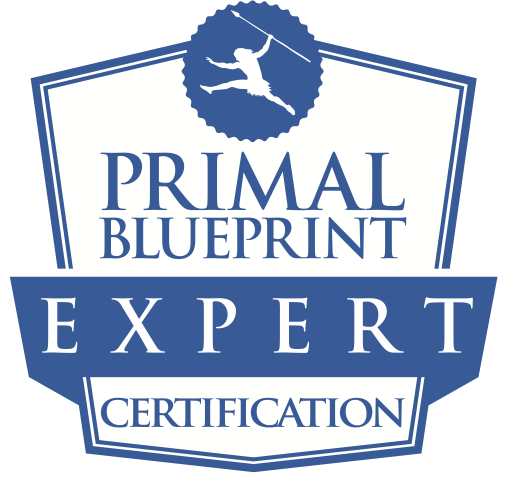 I’m pleased to announce the long-awaited release of the Primal Blueprint Expert Certification program. The Primal Blueprint “Cert” is a comprehensive online educational program that delves deeper into Primal/paleo/evolutionary health principles than any other available resource or course. The Cert is comprised of 13 modules designed around the 8 Key Concepts and 5 Action Items that encompass the Primal Blueprint 21-Day Total Body Transformation book. (Each module is about 4-6x more detailed than its corresponding section in the book!) In addition to the educational course you’ll receive a robust package of multimedia educational materials—instructional videos, audio books and digital books.
I’m pleased to announce the long-awaited release of the Primal Blueprint Expert Certification program. The Primal Blueprint “Cert” is a comprehensive online educational program that delves deeper into Primal/paleo/evolutionary health principles than any other available resource or course. The Cert is comprised of 13 modules designed around the 8 Key Concepts and 5 Action Items that encompass the Primal Blueprint 21-Day Total Body Transformation book. (Each module is about 4-6x more detailed than its corresponding section in the book!) In addition to the educational course you’ll receive a robust package of multimedia educational materials—instructional videos, audio books and digital books.
The certification package truly cultivates the Primal Expert, so that you are empowered to teach others to live Primally. While the program is suitable for certified health, fitness and medical professionals who wish to expand their knowledge and client offerings, it is open to all interested parties with no prerequisites beyond having a decent knowledge of the Primal Blueprint philosophy from reading books and Internet content. That said, this is an intensive educational program that’s equivalent to an upper-division level college course in health sciences, so prepare to get those brain synapses firing!
But don’t worry…my team and I are here to help you along the way. Here’s what to expect:
When you register for the certification, you will receive login instructions to a password-access portal where you can enter the online course as well as access the multimedia educational materials that are yours for the taking. Each module starts with a brief video overview from me, followed by extensive (we hope you find it interesting!) reading material. After watching my summary video and reading the text, we set you free to test your knowledge with an online examination made up of 20-45 questions, a mix of true/false and multiple choice. And there’s no waiting anxiously for your test scores—you get your results immediately. As long as you receive a score of 75 percent correct or better, you can proceed to the next module and work through the program at a fairly rapid pace. But no need to sprint! You can complete the Cert from the comfort of your own home at your own speed—no deadlines ever.
Click the video image below to watch the video and learn more about the Primal Blueprint Expert Certification
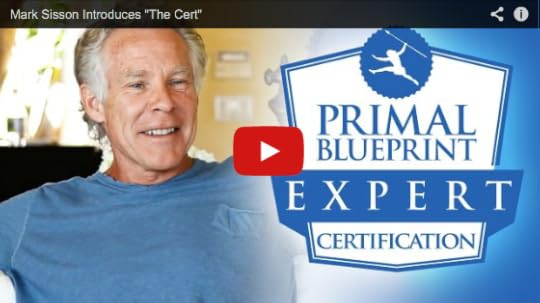
After you have completed all 13 modules and passed their subsequent exams, you have graduated the course! Congratulations are due, so we will ship you a Certified Expert completion kit consisting of an assortment of goodies (including one-of-a-kind Certified Expert apparel!) to celebrate your achievement. You can create a custom profile at our online Certified Expert directory to help you get more clients or just elevate your stature in the Primal community.
It’s a one-time investment of $795, and for that you get a complete educational experience and the resource materials to make you a true expert in Primal living. Naturally, this is a big undertaking for both my company and you, the prospective certified expert. If you have any questions about this course please call 888-774-6259, email or live chat with our staff for more info on what this exclusive opportunity entails.
We are all extremely excited to grow the movement in the best possible way, by deepening your education and empowering you with the tools and knowledge to introduce others to the Primal Blueprint. I would also like to thank you for the overwhelming encouragement and interest you have shown in this program over the past three years. We are very proud of this offering, and I think you’ll agree that your experience was worth the wait!
Click here to learn more and gain immediate access to the official Primal Blueprint Expert Certification online course.





August 26, 2014
The High Cost of Commuting
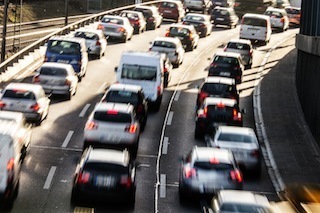 Between gas, car maintenance, bus fare, and train tickets, commuting can get expensive. Driving a mile in the US costs around $0.55, according to the IRS, and some estimates (PDF) even peg this country’s working poor as spending close to 10% of their income on commuting. Financial experts suggest that a one way commute of 20 miles (which is roughly average) will cost you almost $50,000 every ten years. If you’re one of the 600,000 “mega-commuters” who travel at least 90 minutes each direction in the US, your costs skyrocket.
Between gas, car maintenance, bus fare, and train tickets, commuting can get expensive. Driving a mile in the US costs around $0.55, according to the IRS, and some estimates (PDF) even peg this country’s working poor as spending close to 10% of their income on commuting. Financial experts suggest that a one way commute of 20 miles (which is roughly average) will cost you almost $50,000 every ten years. If you’re one of the 600,000 “mega-commuters” who travel at least 90 minutes each direction in the US, your costs skyrocket.
But commuting isn’t just financially costly. It also eats time we could otherwise spend with friends, family, and our children – or getting much-needed sleep. It cuts into leisure time that would be better spent reading, writing, creating, or doing absolutely nothing at all but relaxing and being. It adds constant, chronic stress to our lives. It thrusts us into a daily fight or flight situation with huge metal monsters whizzing by and cutting in front of us. It turns other commuters into our mortal enemies, if only for a minute or two. It makes it harder to prepare and enjoy a healthy home-cooked meal. And it makes us more unhealthy.
In other words, commuting costs us time and money, but it can also cost us life, love, health, sleep, and freedom. Expensive habit, eh?
Let’s take a closer look at the high costs of commuting to see if it’s worth all the trouble.
Commuting makes you unhealthy.
Obviously, time spent in the car is time not spent doing health-promoting things like working out or cooking because you can’t do those while driving (well, maybe you could do kegels or something). The longer your commute, the more it takes away from food preparation (and subsequent consumption of said food), exercising, and other healthy acts. Each minute spent commuting is “associated with a 0.0257 minute exercise time reduction, a 0.0387 minute food preparation time reduction, and a 0.2205 minute sleep time reduction.”
And sure enough, several studies have found strong associations between commute time and poor health. In 2012 (PDF), researchers linked long commutes to less physical activity, lower cardiovascular fitness, larger waists, higher BMIs, and more hypertension in Texas adults. Overall, a long commute predicted poorer metabolic health. Another study found that vehicle miles traveled was the strongest predictor of obesity among Californians. Long commutes may also be more harmful to women than men, with long commuting women dying earlier than short commuting women.
Commuting makes you feel awful.
A recent study shows that with each additional minute of commuting time, we feel worse and worse. Our sense of well-being plummets and our anxiety increases. Oddly, this trend reverses once you hit a three hour commute; people who commute for three hours or more each day report greater life satisfaction. Higher pay (which often accompanies longer commutes) doesn’t seem to make up for the lost happiness, either. According to the study, telecommuters report the greatest satisfaction, lowest stress, and highest sense of well-being.
Commuting is stressful.
The longer the commute, the greater the stress. What’s worse: commuting is a reliable source of stress. You have to do it. It’s always there, lurking in the mind’s periphery. Sunday morning? You’re not focusing on the delicious coffee in front of you. You’re dreading the hour-long drive tomorrow. And the commute itself is fraught with stress, both chronic (the daily grind) and acute (the jerk changing lanes without signaling).
Commuting disrupts your sleep.
Until self-driving cars become available to consumers (a technology I for one eagerly await), commuting necessarily cuts into sleep time. You can’t drive and sleep at the same time, and the longer the commute, the earlier you have to wake up and go to bed if you want good, sufficient sleep. That’s just the morning, though. You also have to consider the commute back home. The more time that takes, the less free time you’ll have at night before you have to hit the hay to get enough sleep. It gets messy fast, particularly because people with long commutes still need to decompress and enjoy themselves at night. They’re not robots who just power down for the night. They’re likely to stay up later and suffer in the morning.
Commuting is lonely.
Even when we’re pushing through the throngs of humanity, we’re alone. No one wants to be there. No one’s cheery enough to chat, except maybe the guy with a quad espresso running through his veins. Most Americans drive to work in single occupancy cars. Millions of us file along the road, isolated and oblivious to the people around us (until they cut us off or drive too close and we yell obscenities). There’s no more robust a predictor of social isolation than a long commute, according to Robert Putnam, a social scientist and expert on the disintegration of American civic life. And social isolation is disastrous for our health and our happiness.
Commuting is the last thing many people want to do.
I mean that literally: a survey (PDF) of women found that commuting, especially in the morning, was the most unpleasant thing they had to do on a regular basis. Unsurprisingly, the women’s favorite acts – sex and socializing after work – are both directly inhibited by a long commute. What makes this even worse is that we have to do this thing we hate more than anything – twice a day, every single day. It’s like a chronic illness that we’ve just learned to accept.
It doesn’t have to be that way, though. You can make changes, tweaks to your schedule, your routine, even your career that either mitigate the deleterious effects of the commute or eliminate them altogether.
Telecommute.
People often assume that telecommuting means slacking off or getting nothing done, but that hasn’t been my experience. Several of my employees telecommute, including my general manager who’s currently living in Australia, and it works out great. I’m a big supporter of telecommuting. Research backs me up, with telecommuters experiencing less work-family conflict, a greater sense of autonomy, less stress, and more job satisfaction. The main potential downside is a lack of personal contact with co-workers, which can modestly harm work relationships (but doesn’t have to).
Try active commuting.
If you really have to commute – and let’s face it, most of us do – try incorporating some active movement like biking or walking. Obviously, if you’re driving 60 miles on the interstate each way to work, biking probably isn’t feasible. But if you’re sitting in traffic for 20 or 30 minutes just to go 15 miles, or taking 15 minutes to drive 2 miles, you could easily do that on a bike or on your feet. Research shows that people who walk or bike to work experience less stress as a result of their commute and rate their mode of transportation as more enjoyable, exciting, and relaxing. They’re still commuting and it’s still taking up free time, but at least they’re getting some exercise out of it, avoiding additional stress, and perhaps even reducing their risk of early mortality.
Change your perception – and reception – of commuting.
When it comes to stress, perception is almost everything. Instead of flipping off the guy who cut you off, ignore it and smile. Don’t use the horn vindictively. Use it prophylactically to prevent accidents or warn other drivers. I mean, who really cares that a guy didn’t let you in or forgot to use a blinker or honked at you? Don’t give in to the anger welling up because someone did something in a car near you. It does nothing but make your commute more stressful. You may have to fake it until you make it, but you’ll be reciting zen koans and perceiving the cosmic oneness of all mankind on the commute in no time.
Make your commute enjoyable.
If you’re sitting in traffic, you should try to enjoy yourself. Don’t listen to AM talk radio hosts whose alignments run opposite yours. Don’t wallow in “anger porn.” Heck, I’d avoid politics altogether. Instead, listen to good music. Throw on audiobooks. Subscribe to a podcast or two. Make the most of your situation.
Change jobs.
I know, I know. It’s sacrilege to even suggest this, but switching to a lower-paying job with an easy or nonexistent commute might be worth it. You’ll have more time with your family and friends. You’ll have more time with yourself. You’ll get more sleep. You can finally go take that krav maga or yoga class you’ve been considering. You’ll save on gas and wear-and-tear car repairs. You might actually get a chance to cook a real Primal meal every night rather than pick up something resembling food on the way home. And a new job doesn’t even have to mean lower pay. You might find something closer and better-paying and more interesting if you actually rouse yourself from homeostasis and go look. Pursuing your dream can work.
Since nearly everyone commutes, and most of you are probably reading this at work or en route to work, I hope you’ll really consider the thrust of today’s post. It’s not an easy thing to confront the possibility that we’re actively curtailing our health and happiness on a daily basis, nor is it simple to change gears and make a huge shift, but it might be a good move. Let me know what you guys think in the comment section. Thanks for reading!
Not a Subscriber? You Are Missing Out. Subscribe for Free Today and Instantly Get 8 Primal eBooks and So Much More!




Mark Sisson's Blog
- Mark Sisson's profile
- 199 followers



